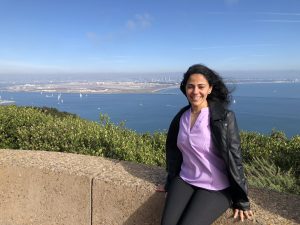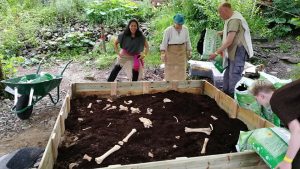Nesreen. A. El-Galy - 2017 - Oxford University D.Phil Scholar
 In October 2017, I was given the opportunity to be an Honor Frost Scholar to pursue my D.Phil, which is a great honour for me. I believe that I will be able to contribute and make a difference in my field of research. Additionally, it allows me to meet new people and interact with various cultures and backgrounds, as well as demonstrate my leadership, management, and teambuilding skills. I am pursuing a D.Phil that will enable me to deepen expertise in this field and contribute new research and findings to the area of Maritime Archaeology. Significantly, I am the first female in Egypt to specialise in ancient naval architecture and marine engineering research.
In October 2017, I was given the opportunity to be an Honor Frost Scholar to pursue my D.Phil, which is a great honour for me. I believe that I will be able to contribute and make a difference in my field of research. Additionally, it allows me to meet new people and interact with various cultures and backgrounds, as well as demonstrate my leadership, management, and teambuilding skills. I am pursuing a D.Phil that will enable me to deepen expertise in this field and contribute new research and findings to the area of Maritime Archaeology. Significantly, I am the first female in Egypt to specialise in ancient naval architecture and marine engineering research.
My D.Phil builds on the knowledge that I developed for my Master’s degree that combined personal observation and recording of ancient Egyptian boat models to reveal the characteristics of their hulls focusing on archaeological data for hull design, structure, and stability. My research aims to investigate:
- Whether boat models were miniature representations of reality, i.e. were they accurate representations of the diverse types of ships and boats that were sailing on the Nile during the period they were created?
- Alternatively, were the models simply abstract representations chosen to represent themes for the rituals associated with burial. If so, such models need not be nautically accurate in their construction and as such could be more representational and decorative in their construction.
 My early work on the models has suggested that their hulls are hydro-dynamically efficient and that they could have effectively functioned in the fluvial landscape of the Nile. This indicates that ship and boat models can be used to augment the sparse nautical archaeological evidence from Egypt, which for the periods under consideration in this thesis, have a limited number of vessels and vessel timbers. Here, the range of different types of vessels modelled by ancient Egyptian craftspeople adds to the corpus of information on the ships and boats that were in use on the Nile. This is because the nautical evidence is biased towards vessels from ritual contexts – overwhelmingly boat burials from tomb contexts – whereas the models encompass personal vessels, hunting, cargo, and travelling boats, as well ritual vessels.
My early work on the models has suggested that their hulls are hydro-dynamically efficient and that they could have effectively functioned in the fluvial landscape of the Nile. This indicates that ship and boat models can be used to augment the sparse nautical archaeological evidence from Egypt, which for the periods under consideration in this thesis, have a limited number of vessels and vessel timbers. Here, the range of different types of vessels modelled by ancient Egyptian craftspeople adds to the corpus of information on the ships and boats that were in use on the Nile. This is because the nautical evidence is biased towards vessels from ritual contexts – overwhelmingly boat burials from tomb contexts – whereas the models encompass personal vessels, hunting, cargo, and travelling boats, as well ritual vessels.
The first year of the research was dedicated to developing a research methodology, learning how to build boat models in a 3D environment, and selecting the most appropriate nautical architecture software for use in my thesis. The second year entailed me learning how to use this software and apply its forms of analysis to boat models. The software enables me to analyse the nautical capabilities of the models that form the corpus of my research. The third year was occupied with diverse activities and pieces of training. Working beyond Egypt in either terrestrial or maritime archaeology was an aim of mine, as it would help broaden my professional horizons. I consequently joined an excavation on the site of Petrarossa in the Umbrian municipality of Trevi, Italy. After four weeks, we discovered ~50 square metres of well-preserved Roman mosaics featuring a series of marine motifs as well as marble statues and decorated pottery. Additionally, I spent two weeks working with the Pittencreiff field school in Scotland. Through this fieldwork, I have been trained in landscape and pottery drawing, site mapping, stratigraphic matrices, and bone casting. I also had the opportunity to share some archaeological experience with young archaeologists aged ~10-16 years old. This workshop took place over two days, during which I gave instruction on the basic principles and procedures of working on archaeological sites. I ended the year working with the IEASM team in Alexandria, Egypt, on the digital reconstruction and nautical analysis of wreck J3 that was excavated in the Portus Magnus. My supervisor, Damian Robinson, invited me to work on this project to test and utilise my skills on a full-sized boat.
 The Fourth year was full of challenges and the COVID-19 tragedy; however, it was still full of achievements for me. In June 2021, I have successfully passed the Confirmation of Status Exam, the final academic milestone before the viva voce oral test. I am now at the final stages of putting my research together. I refer to this stage as “Research Polishing.” I am very proud of my work so far; however, it is condensed with technical terms that need to be made more reader-friendly. The value of my work lies in the ability of a reader to learn something and piqued their curiosity to explore the topic further.
The Fourth year was full of challenges and the COVID-19 tragedy; however, it was still full of achievements for me. In June 2021, I have successfully passed the Confirmation of Status Exam, the final academic milestone before the viva voce oral test. I am now at the final stages of putting my research together. I refer to this stage as “Research Polishing.” I am very proud of my work so far; however, it is condensed with technical terms that need to be made more reader-friendly. The value of my work lies in the ability of a reader to learn something and piqued their curiosity to explore the topic further.
“What we have done for ourselves alone dies with us; what we have done for others and the world remains and is immortal. Albert Pike”
